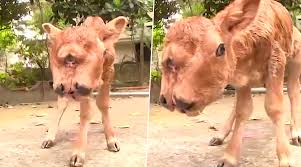DICEPHALIC MONSTER IN CATTLE & BUFFALO
Monsters are the developmental abnormalities that cause distortion of organs and body systems. Congenital abnormalities or malformations such as duplication of the body structures caused due to abnormal duplication of the germinal layer i.e. the abnormal duplication of the inner cell mass in an embryo gives rise to fetuses whose body structures are partially but not completely duplicated (Roberts, 1971). Dystocia is a common sequel of such monstrosity and most of the cases are resolved either by fetotomy or caesarean section.Fetal malformation, anomaly and monstrosities are common causes of dystocia in bovines. Anomalies which occur due to congenital defects often lead to dystocia. An increased number of still birth, maternal injury and calf mortality are some of the severe consequences associated with dystocia which lead to economic losses (Mollalign and Nibret, 2016) . Fetuses with congenital defects are dead usually but sometimes die within hours or few minutes after birth. Congenital defects may lead to dystocia as it is difficult for monsters to pass through the birth canal because of feto-maternal disproportion. Dystocia due to monsters is usually relieved by caesarean section since fetotomy cannot be applied for each and every monster and it has its limitations (Purohit et al., 2012) . Polycephaly is a congenital malformation in which an individual with two (dicephaly) or more heads occur probably due to partial or total union of two developing embryos or to a partial duplication of a body or to the antero-posterior compression of the embryonic disk (El-Sheikh et al., 2010) . Duplication of cranial part of the fetus is more common than of the caudal parts (Gangwar et al., 2015) . The increase in relative size of fetus due to dicephalus monster result in dystocia as it is very difficult to pass through birth canal.
Terminology-Conjoined twins with : Two separate heads (Dicephalus), Two fore limbs(Dibrachius), Two hind limbs (Dipus), Two tails (Dicaudatus)
Compiled & Shared by- Team, LITD (Livestock Institute of Training & Development)
Image-Courtesy-Google
Reference-On Request.


